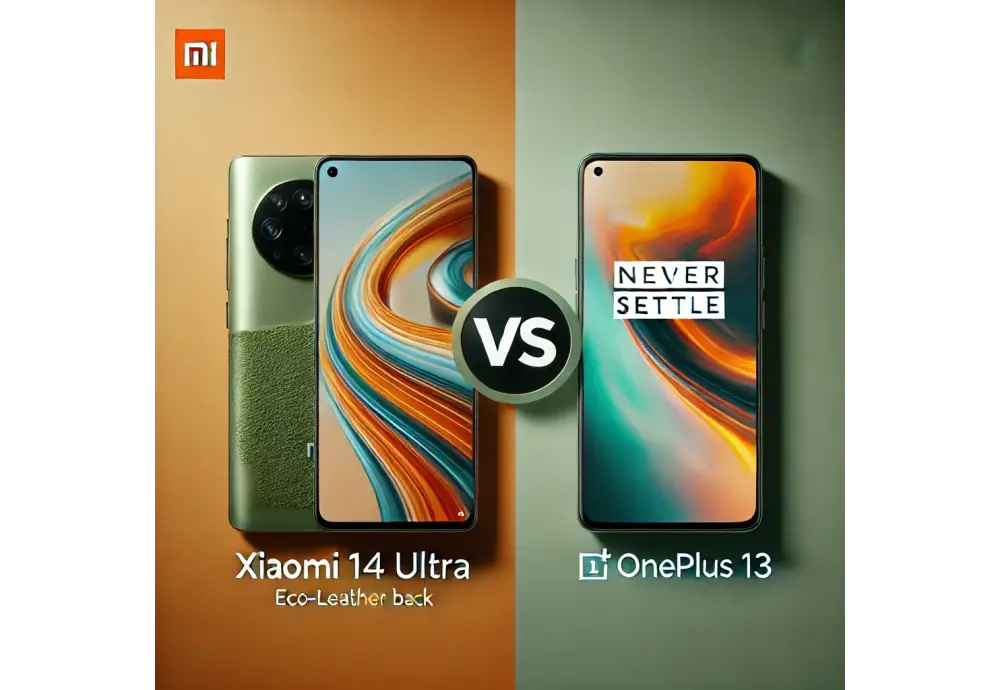
When it comes to flagship smartphones, the OnePlus 13 and Xiaomi Mi 14 Ultra represent the pinnacle of innovation, power, and design. Released within months of each other, these devices cater to tech enthusiasts seeking cutting-edge features and exceptional performance. Let’s delve into a detailed comparison of these high-end smartphones to help you make an informed choice.
Design and Build Quality
Both devices showcase premium materials and craftsmanship, but there are distinct differences:
Xiaomi Mi 14 Ultra: Built with a Shield Glass front, glass or eco-leather back, and a titanium (grade 5) or aluminum alloy frame. It’s slightly heavier at 219.8-229.5 g, reflecting its robust construction. The dimensions are 161.4 x 75.3 x 9.2 mm, making it marginally thicker and more compact.
Display Technology
Display quality is a significant factor for any flagship smartphone, and both models deliver stunning visuals:
Xiaomi Mi 14 Ultra: Features a slightly smaller 6.73-inch LTPO AMOLED display with 68B colors, 120Hz refresh rate, Dolby Vision, and HDR10+. Its peak brightness is 3000 nits, which is excellent but lower than the OnePlus 13. The resolution of 1440 x 3200 pixels (~522 ppi) delivers a comparable sharpness.
Performance
Performance is crucial for multitasking, gaming, and demanding applications:
Xiaomi Mi 14 Ultra: Equipped with the Snapdragon 8 Gen 3 chipset (4 nm) and an Octa-core CPU (1x3.3 GHz Cortex-X4, 3x3.2 GHz Cortex-A720, 2x3.0 GHz Cortex-A720, 2x2.3 GHz Cortex-A520). The Adreno 750 GPU ensures smooth graphics performance. Storage options include up to 1TB/16GB RAM with UFS 4.0.
Camera Capabilities
Camera technology is a defining feature for these flagship devices:
Xiaomi Mi 14 Ultra: Offers a quad-camera system with four 50 MP sensors for wide, telephoto, periscope telephoto, and ultrawide shots. Unique features include Leica lenses, a color spectrum sensor, and an optional 67mm filter ring. It also supports 8K video with gyro-EIS and Dolby Vision.
Battery and Charging
Battery performance and fast charging are vital for heavy users:

OnePlus 13: Houses a Si/C 6000 mAh battery with 100W wired charging (50% in 13 minutes, 100% in 36 minutes). Wireless charging is supported at 50W, along with 10W reverse wireless and 5W reverse wired charging.
Xiaomi Mi 14 Ultra: Features a 5000 mAh (international) or 5300 mAh (China-only) battery with 90W wired charging (100% in 33 minutes). Wireless charging is slightly faster at 80W, with 10W reverse wireless charging.

Verdict: The OnePlus 13 offers faster wired charging and a larger battery capacity, making it ideal for power users.
Software and Updates

OnePlus 13: Runs Android 15 with OxygenOS 15 (International) or ColorOS 15 (China), promising up to 4 major Android updates.
Xiaomi Mi 14 Ultra: Ships with Android 14 and HyperOS, also ensuring 4 major Android updates.
Conclusion
Both the OnePlus 13 and Xiaomi Mi 14 Ultra excel in their respective domains, making it challenging to declare an outright winner. If you prioritize peak display brightness, cutting-edge performance, and fast charging, the OnePlus 13 is the better choice. However, if you value superior camera versatility and a durable titanium frame, the Xiaomi Mi 14 Ultra is worth considering. Ultimately, your decision should align with your personal preferences and use case scenarios.















